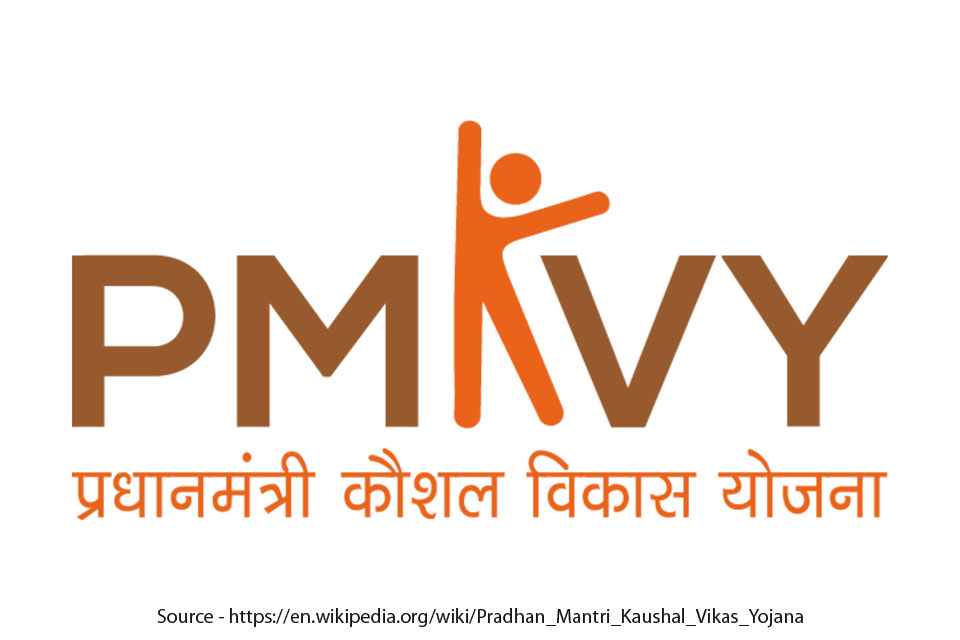Pradhan Mantri Kaushal Vikas Yojana
May 19, 2025 2025-05-19 7:39Pradhan Mantri Kaushal Vikas Yojana

Pradhan Mantri Kaushal Vikas Yojana
By Shristi Srivastava
Executive Summary –
Launched in the year 2015, the Pradhan Mantri Kaushal Vikas Yojana was brought with an objective to provide or develop skill training amongst the unemployed 10th, 12th and Diploma passed youths to make them self- sufficient and self-reliant. It aims that developing industry required skill which will help them in securing better livelihood. It is the flagship scheme of the Ministry of Skill Development and Entrepreneurship (MSDE) implemented by National Skill Development Corporation (NSDC). Despite its large-scale reach, PMKVY faces challenges related to quality, placement, and regional disparities. This brief outlines its background, achievements, key concerns, and recommends measures to strengthen the scheme.
Background –
India faces a paradox of skill shortage amidst a large young population. To bridge the skill gap and enhance employability, PMKVY was launched under the National Skill Development Mission. It is further classified as –
| Major Dimensions | Qualifications – |
| Short -Term Training (STT) | College Dropouts/Unemployed Youth |
| Recognition of Prior Learning (RPL) | Individuals with some prior skills and experience |
| Special Projects | Any statuary body/government institution or autonomous body who desire to provide training to their candidates |
The scheme has undergone multiple phases – PMKVY 1.0 (2015-16), PMKVY 2.0 (2016-20), PMKVY 3.0 (2020-21) and PMKVY 4.0 (2021 – to present).
Key Features –
| Key Features | Primary Stakeholders | Mechanism | Duration |
| Short Term Training (STT) | Individuals who are either school/college dropouts or unemployed | Training imparted at the training centres in accordance with the National Skill Qualification Framework (NSQF) with components such as soft skills, entrepreneurship, financial and digital literacy | Ranges between 2-6 months. On completion, and certification, candidates are provided placement assistance by Training Partners (TPs). |
| Recognition of Prior Learning (RPL) | Individuals who have prior experiences or skills | Aims to align the competencies of the unregulated/informal workforce of the country to the NSQF. | 12—80 hours |
| Special Projects | Encourage training in special areas and premises of Government bodies, corporates/industry bodies and trainings in special job roles not defined under the available Qualifications Packs (QPs)/National Occupational Standards (NOSs). | Differs from stakeholders to stakeholders | Given its special nature, the projects might require a bit deviation from the STTs. |
Key Issues –
- Weak Industry Linkages – Though PMKVY aims to provide a full coverage to unemployed youth by working on its core, weak industry linkages stumble the penetration of the policy. The trainings under the PMKVY fails to encapsulate the changing nature of the work and skills required to build further on it. Based on the report prepared by the standing committee, training courses, curriculum and practical skills imparted under PMKVY are not in alignment with the industry requirements.
- Regional Imbalance – the PMKVY is heavily dependent on the training centres, thus an imbalance in the positioning of the training centres will lead to potential exclusion of the youth. The uneven distribution of the training centres particularly in the rural and underserved regions of the country, makes the unemployed youth of these regions marginalized and vulnerable with respect to policy intervention. During the implementation of the PMKVY 1.0, 2.0, and 3.0 about 20% of the total enrolled candidates dropped out of the programme and one of the reasons for the dropouts includes distance from residence to training centres amongst others.
- Lack of Placements – Though the policy does aims to provide the full-time placements to its trainees, the implementation on the same front has not been able yield desired results. A significant proportion of the trained individuals do not find a suitable job. For instance, under PMKVY 2.0, out of 91.4 lakh candidates, only 21.3 lakh candidates were placed (23%) whereas under PMKVY 3.0, out of 4 lakhs candidates, only about 30,599 just 8% have been placed. [1]
[1] Facts based on the report submitted by the standing committee on Labour, Textiles and Skill Development – https://prsindia.org/policy/report-summaries/implementation-of-pradhan-mantri-kaushal-vikas-yojana - Variable Training Standards – The ununiform training standards/modules across the training centres under PMKVY poses another serious challenge in its fine implementation. Over the years, the inconsistent standards of the training providers as well has come to fore.
- Weak Monitoring and Evaluation – A weak framework of monitoring and evaluation of the PMKVY has further placed the policy far away from its desired outcomes. For instance, Andhra Pradesh, Gujarat, Nagaland and Tripura do not have an online management system, the committee noted that an online management system will benefit states[2].
Recommendations –
- Strong Industry Linkages – A strong and robust relationship with the industry experts will enhance the efficiency and effectiveness of the policy making it relevant and up to the mark with the market standards. Industry experts are an important stakeholder in the policy and if consulted, they could play an important role in the module designing to ensure demand driven skills.
- Promotion of Regional Equality – The training centres must be positioned in a way that it caters to all irrespective of the geographical location. A formula such as 1 centre within the range of 30-50 kilometres could be adopted ensuring transportation to the centres is well established.
- Placements Drives – The Government in collaboration with the private sectors can arrange for the placement drives for the individuals trained under the PMKVY. To promote the entrepreneurial spirits, steps such as seed funding or mentoring from the industry experts could be arranged as post training support system.
- Strengthen Monitoring and Evaluation Framework – A well-established monitoring and evaluation mechanism is very crucial to have proper implementation of the scheme. Timely feedback mechanism, redressal of grievances, transparency, placements outcomes, evaluations of the training centres and providers with verifiable indicators (OVI) and means of verification (MOV) must be brought in place to ensure accountability and responsibility. A real time digitally integrated platform could be built to track the progress of trainings, efficiency of he trainers, placements and sectoral demands.
[1] Facts based on the report submitted by the standing committee on Labour, Textiles and Skill Development – https://prsindia.org/policy/report-summaries/implementation-of-pradhan-mantri-kaushal-vikas-yojana
References –
- Ministry of Skill Development and Entrepreneurship (MSDE) – https://www.msde.gov.in
- PMKVY Official Website – https://www.pmkvyofficial.org
- NITI Aayog Evaluation Reports (2020, 2022)
- Parliamentary Standing Committee Report on Skill Development (2021)
- NSDC Annual Reports.
- https://nsdcindia.org/pmkvy-overview
- https://prsindia.org/policy/report-summaries/implementation-of-pradhan-mantri-kaushal-vikas-yojana
[1] Facts based on the report submitted by the standing committee on Labour, Textiles and Skill Development – https://prsindia.org/policy/report-summaries/implementation-of-pradhan-mantri-kaushal-vikas-yojana
[2] Facts based on the report submitted by the standing committee on Labour, Textiles and Skill Development – https://prsindia.org/policy/report-summaries/implementation-of-pradhan-mantri-kaushal-vikas-yojana






